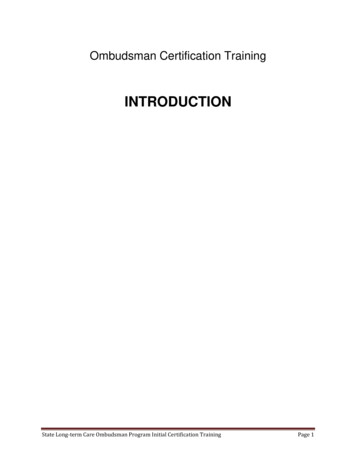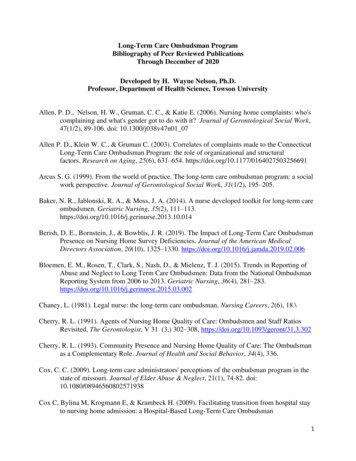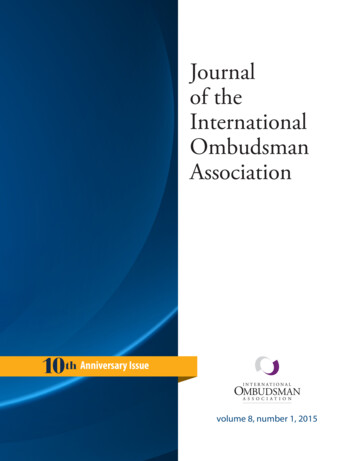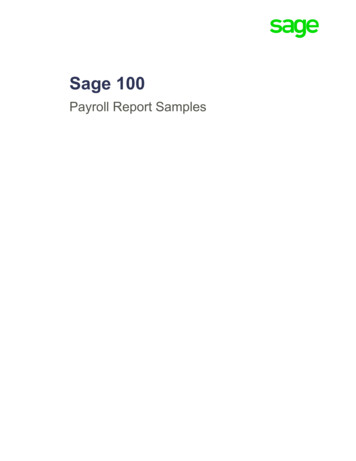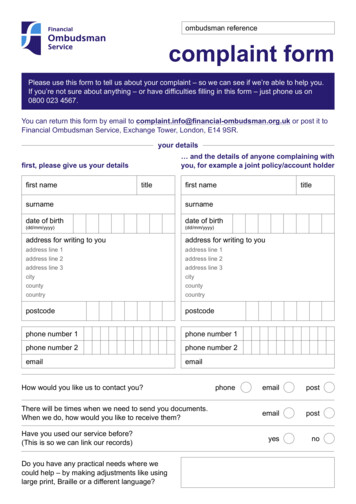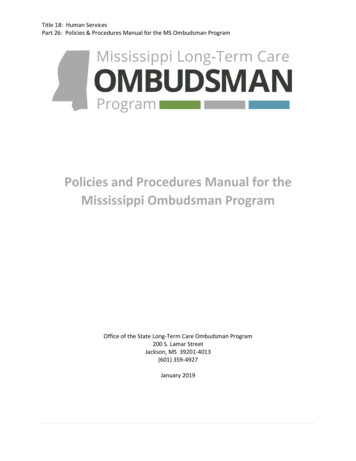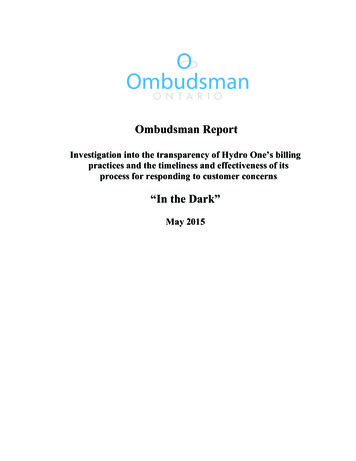
Transcription
Ombudsman ReportInvestigation into the transparency of Hydro One’s billingpractices and the timeliness and effectiveness of itsprocess for responding to customer concerns“In the Dark”May 2015
Table of ContentsTable of Contents . 3Executive Summary . 5Investigative Process . 7Hydro One: The Power that Be . 10System Refresh . 10Egregious Errors and Baffling Bills . 12Who Are You Going to Call? Customer Complaints . 16Post-Launch Calls and Complaints . 17Customer Relations Centre Backlog . 18Technical Glitches . 19Defects Detected . 19Exceptions Prove the Rule . 22No Bills . 23Wrongly Addressed Bills . 25Never Billed . 25Estimated Bills . 25Electric Personality – Inward-Facing Culture . 26Poor Customer Service: A Symptom, Not the Disease . 28From A to Failing Grade – Systems versus People . 30Communications Gap . 33Keeping Outsiders in the Dark . 35Obstructing the Ombudsman . 36Obfuscating the Ontario Energy Board . 37Mollifying the Minister’s Office. 38Befuddling the Board of Directors. 38Inside Crisis – Outside Calm . 40Light Bulb Moment: Too Late to Apologize? . 40An “Innocuous” 30-Million Error. 41Ombudsman Intervention . 41Reputation Rehabilitation Begins . 42Centering on Customers. 44Corrupted Communications Culture . 47Operational Missteps . 48Training Wreck . 48It’s Alive!!! – System Implementation. 51Call Centre / Pressure Cooker . 52Call Quality Assurance, Please Hold . 55Surveying the Situation. 58Knowing the Real Score: Performance-Based Compensation . 60Lessons Unlearned . 62Sunny Days Are Here Again . 65Refund or Discredit . 68Unclear Bills . 69
Confusing Complaints Process. 70The Power of Apology . 71Crossed Wires – Billing Resolution Duplication . 71Cultural Differences: Failing the Culture Change Test . 72Committing to Customer Commitments . 74That’s Cold - Winter of Our Disconnect . 77Credit Collection – Owing an Apology. 82Relying on Technicalities – Customer Beware . 83It's a Little Dense - Density Classifications . 83General Disservice – General Service Billing . 85Two Years Too Late – Retroactive Charges . 88Giving Credit Where it is Due . 89Still Looking on the Bright Side . 90Current Events and Hydro One’s Future. 94Opinion . 95Recommendations . 95Hydro One, Inc. . 95Considering customers . 95Communicating openly and transparently . 96Improving staff training and supports . 96Enhancing call intake and quality monitoring . 97Transforming corporate culture and governance . 98Improving customer service practices . 99Committing to customers . 100Improving collection practices. 101Clarifying classifications . 101Lessons learned . 103Progress reports. 103Government of Ontario . 103Response . 104Appendix A – Ministry Response . 105Appendix B – Hydro One Response . 109
Executive Summary1Large public sector corporations carrying on monopolistic commercialenterprises can sometimes forget the citizens they were created to serve. HydroOne, which distributes electricity to 1.3 million Ontario consumers, made acritical mistake when installing a new billing and account management systemin May 2013. In planning for and implementing its “customer informationsystem” to meet its business goals, Hydro One lost sight of its public interestpurpose and failed to adequately consider the impact on its customers. Itsoverconfidence in its technical superiority fostered complacency. When glitchesarose with the new system, Hydro One’s first response was to scramble fortechnical fixes. It forgot to consider the consequences to its customers.2Soon after the system changeover, more than 89,000 customers stoppedreceiving bills. Some were not billed under the new system for months, whileothers only received bills based on estimates for prolonged periods. Then, astechnical glitches were being addressed, the system issued a flurry of multipleinvoices and huge “catch-up” bills, leaving customers frustrated and confused.Many had large sums withdrawn automatically from their bank accounts withoutnotice or explanation. Tens of thousands of accounts were affected by bizarreerrors, as Hydro One worked frantically to clear unexpected system problems.Hydro One’s outsourced call centre and its in-house customer relations centrewere left to cope with the ensuing flood of calls and complaints without propertraining or adequate tools and resources. Workload pressures contributed to rude,insensitive, and substandard customer service.3Hydro One’s board of directors and executive managers claimed they werecaught off guard and oblivious to the developing crisis. They blamed lower-levelmanagers for presenting them with overly optimistic reports. Some Hydro Onerepresentatives deliberately kept the situation under wraps, deflecting mediainquiries and even deceiving the electricity regulator, my Office and otherstakeholders about the extent and nature of the company’s billing and customerservice disaster.4Hydro One tried to contain reputational damage by dealing quietly andreactively with issues as they arose. Whenever bad publicity surfaced in thepress, Hydro One adopted a dismissive and minimizing approach, claiming thatonly a small percentage of its customers were affected by the billing problems.Its statistics and descriptions of the issues were nebulous and shifted over time,however, it ultimately confirmed that in February 2014, 84,394 customers were5“In the Dark”May 2015
either receiving multiple estimated bills or had not received a bill for more than90 days. When one adds the thousands who experienced hardship as a result ofother system errors and billing inaccuracies since May 2013, the tally of thoseaffected by Hydro One’s bungling is likely well over 100,000.5Until February 2014, when I launched my investigation and Hydro One’s coverwas effectively blown, the company feverishly tried to spin positive news stories.Since then, it has faced a crisis of confidence that has rocked it to its publicsector core and damaged its financial bottom line. Hydro One has paid a heftyprice trying to make things right, spending more than 88 million to dig its wayout of controversy and restore public trust.6My Office received an unprecedented number of complaints in connection withthis investigation – 10,565 as of the writing of this report, and counting. Whilethe volume has dropped markedly over the last year, we continue to hear fromabout a dozen people a day who remain concerned about Hydro One’s billingand customer service.7The source of Hydro One’s mind-boggling maladministration does not lie indefective data and software programming. Rather, its fatal fault is a technocraticand inward-facing organizational culture that is completely out of step withpublic sector values. Even after Hydro One pledged to become more customercentric, to do better, and to learn from its mistakes, it continued to displayinsensitivity and disregard for its customers. As late as February 2015, duringthe coldest month in Ontario’s recorded history, the company lied to and bulliedcustomers with the threat of disconnection.8Hydro One’s ordeal has underscored an expensive lesson in publicadministration: Its customers must be considered in every aspect of itsoperations. Although the Chief Executive Officer and President has offered apublic mea culpa and several changes have been made to improve customerservice, much remains to be done to bring the company up to the standardOntario’s citizens deserve.9The Ontario government has recently announced plans to significantlyrestructure Hydro One, including disposing of 60% of the utility, while retaininga 40% ownership interest. It has also proposed to appoint an in-houseombudsman to address customer complaints about the new privatized utility. Myinvestigation demonstrates that Hydro One has historically not lived up to theprinciples of good public administration expected of Ontario’s public bodies.During the recent billing and customer service fiasco, its customer service wasabysmal by any standard. A corporate ombudsman’s loyalty is ultimately to theemployer it serves and is no substitute for independent investigative oversight.6“In the Dark”May 2015
In introducing structural changes to Hydro One’s operations, the government ofOntario should ensure that the public interest in fair, timely and effectivecustomer service is preserved, including the right of recourse to my Office.10I make 66 recommendations in this report, 65 addressed at reorienting HydroOne’s corporate persona and improving its operational practices to better servethe public interest, reflecting the public sector values of openness, transparencyand accountability. Hydro One has accepted all of these recommendations.Recommendation 66 is aimed at ensuring that implementation of myrecommendations continues as the Government of Ontario moves forward withthe proposed restructuring of Hydro One. Regrettably, in responding to thisrecommendation, the Ministry of Energy has confirmed that the government’sprivatization plans include abandoning independent and external oversightthrough my Office.11I will monitor Hydro One’s progress in fulfilling its commitments. I will alsocontinue to encourage the government to retain existing accountabilitymechanisms, including Ombudsman oversight of Hydro One and any successorcorporation. My report clearly documents Hydro One’s failure to communicateopenly, honestly and proactively with its customers, its regulator, Ministryofficials and my Office. I am concerned that unless accountability is assuredthrough independent and impartial scrutiny, stakeholders may once again findthemselves in the dark.Investigative ProcessMy Office first noticed a rising trend in Hydro One complaints in 2012-2013,when we received 328, up from 232 the previous year.1 In 2013-2014, thatnumber more than doubled, reaching 647 by early February 2014. Mostcomplaints focused on bills that were wrong, excessive, duplicated,unreasonably delayed or estimated based on unclear criteria. Our attempts toresolve customer concerns were also increasingly met by stonewalling by HydroOne officials, a frustrating experience I likened to “wrestling with a slipperypig.”2 We were particularly concerned about people who found themselves invulnerable situations and facing significant financial hardship and stress becauseof their dealings with Hydro One.121Ombudsman Ontario, Annual Report 2012-2013, p. 29. 012-2013-Annual-Report.aspx#Ministry of ts7“In the Dark”May 2015
13Common complaints involved large “catch-up” bills issued to customers whohad received estimated bills or no bills for long periods, and who were givenlittle time to pay or explanation for the amounts billed. Many also cited longwaits, for what turned out to be inadequate information from Hydro One’scustomer service operations.14Given the rising complaint volume and our own experience with Hydro One’sdelayed and reticent response to our inquiries, on February 4, 2014, I announceda systemic investigation into complaints about serious problems with billing andcustomer service at Hydro One. I stated that the investigation would focus on thetransparency of the utility’s billing practices and the timeliness and effectivenessof its process for responding to customer concerns.15The investigation was assigned to the Special Ombudsman Response Team(SORT). A team of seven investigators carried out the investigation under thedirection of SORT’s director and with the assistance of senior counsel.16My Office received more complaints about Hydro One than we have about anysingle organization in our 40-year history. In addition to the original 647complaints, nearly 10,000 poured in after the investigation was announced. Todeal with this unprecedented volume, my Office took a two-pronged approach:While SORT pursued the broad systemic issues, a team of 12 early resolutionofficers and investigators triaged Hydro One complaints, and referredcomplainants elsewhere if their issues were outside the scope of our authority.Another 12-member dedicated team resolved individual cases with a 10-memberteam that Hydro One created in February 2014 as a special “SWAT” team todeal with cases from my Office. Not all complaints to our Office requiredreferral to or follow-up by Hydro One. However, since April 2013, 4,142complaints have been resolved through our intervention and Hydro One’s efforts.My Office’s director of investigations and senior counsel also met regularly withsenior Hydro One officials throughout the investigation.17I met with the Chief Executive Officer and President of Hydro One severaltimes and addressed systemic themes that we identified. I also took a turn on thephone lines alongside my staff to hear complainants’ concerns firsthand.18SORT conducted 190 interviews, including with current and past Hydro Oneexecutives, outsourced agencies that perform work on behalf of Hydro One,complainants and stakeholders.19Our attempts to identify and interview relevant Hydro One staff werecomplicated by a significant degree of transition within the company’smanagement. During the first month of the investigation, two customer service8“In the Dark”May 2015
executives left the company; one retired, the other was terminated. The samemonth another key official departed to join another company. At least six otherexecutives shifted positions as the investigation proceeded, and leadership at theoutsourced call centre changed.20SORT investigators requested briefing sessions with Hydro One at the beginningof the investigation to get an overview of its billing system and some of thetechnical issues relating to billing. Investigators also met with representativesfrom other agencies, including the Ontario Energy Board and the IndependentElectricity System Operator.21As well, some 25 industry insiders and whistleblowers, including current andformer Hydro One staff and staff from its outsourced service providers,contacted us to express concerns about billing and customer service issues. Theyprovided us with helpful insights into the culture of the company.22Site visits and interviews with staff were conducted at Hydro One’s twooutsourced call centres, in Markham and London, Ont. At both locations, ourinvestigators had an opportunity to monitor call centre agents as they handledcustomer calls.23SORT made two formal requests and several additional requests for documentswhen it became clear some relevant information was omitted. The bulk of thedocumentation reviewed was in electronic format – on 10 USB keys, equivalentto more than 23,000 pages of printed material. In addition, in response to ourrequest for the electronic communications of 12 Hydro One staff, we received ahard drive containing 151,471 emails.24In addition to complaints about Hydro One billing and customer service, wereceived many complaints about subjects that were not the focus of thisinvestigation – chiefly, electricity pricing and smart meters. The Ontario EnergyBoard approves the rates that utilities can charge customers for electricity. Asfor the smart metering initiative, at the time my investigation was launched, itwas already under scrutiny by the Auditor General of Ontario. Her findings werereported on December 9, 2014, in her annual report, in which she also identifiedconcerns with billing problems at Hydro One. Included among herrecommendations were calls for improved tracking of inquiries and complaints,better education of ratepayers and fixing problems with the billing system.33This section of the Auditor General’s report can be found here:http://www.auditor.on.ca/en/reports en/en14/311en14.pdf9“In the Dark”May 2015
25SORT also reached out to other utilities to learn about best practices in Canadianand international jurisdictions. Ontario is the only province that mandates timeof-use pricing for electricity and one of a few Canadian jurisdictions to usesmart meters to collect time-of-use information.26Given the unprecedented volume of complaints, and strong interest fromcomplainants, Hydro One customers and public officials, I issued a brief publicupdate on my investigation on March 11, 2015.4Hydro One: The Power that Be27Hydro One Inc., the largest electricity transmission and distribution company inOntario, is wholly owned by the provincial government, which appoints itsboard of directors. It operates in association with five subsidiaries5 and has 22.6 billion in total assets. Hydro One generates significant public profits. In2013, Hydro One’s net income was 803 million, which resulted in a 218million dividend payment to the province.28The company provides direct service to 21 remote communities and some 1.3million rural and urban distribution customers. It issues about 1 million bills amonth. Since 2002, Hydro One has outsourced customer call handling, billing,credit and collections to a private operator. Initially, Hydro One retained InergiLP to run its call centres. That company in turn subcontracted this responsibilityto Vertex Customer Management (Canada) Ltd. As of March 1, 2015, Inergi LPis directly responsible for these outsourced services under a new three-yearagreement.System RefreshIn 2011, as part of a four-phase, multi-year project to refresh its informationtechnology systems, Hydro One allocated 180 million to replace its customerinformation system. The existing system was operating on an old platforminstalled in 1998, which was no longer supported by the vendor. Hydro Onepredicted that the new system would improve customer service and yield up to 172 million in financial benefits over a seven-year period. The initial target294The update can be found online here: -.aspx5The five subsidiaries are: Hydro One Networks Inc. (which had primary accountability for the issues Iinvestigated), Hydro One Remote Communities Inc., Hydro One Telecom Inc., Hydro One BramptonNetworks Inc., and Norfolk Power Distribution Inc.10“In the Dark”May 2015
date for the new system to be implemented – or “go live,” in the company’sparlance – was over the October 2012 Thanksgiving long weekend.30The company had successfully replaced other internal information systems aspart of the project, but the last phase was the first to have, in Hydro One’sphrase, “a direct customer-facing impact.” The customer information system isused for many customer service functions, including billing and accountmanagement. It is also an important resource for call centre staff, who handleabout 1.5 million customer calls and 280,000 items of correspondence each year.31Hydro One estimated that the new system would increase the number of callsresolved on the first contact with the call centre by 5%, while decreasing theaverage call handling time by 20 seconds, and the average correspondencehandling time by 16 seconds.32It was understood that with any system change, customer complaints wouldlikely increase in the short term. Hydro One predicted that for routine matters,call volume and average handling time would increase by about 20% in the firstmonth, but would normalize by the five-month mark. It also projected a 25%increase in the averagehandling time and volume formore complicated calls in thefirst month, but expected theseto normalize within 10 months.33Our investigation revealedthat Hydro One’s forecastsfell glaringly short of the mark.For starters, theimplementation date wasdelayed by seven months. Thenew customer informationsystem did not “go live” untilthe May 21, 2013 VictoriaDay long weekend.34Still, the company cautiouslycelebrated the success of thenew system. In an internalnewsletter on the day of thelaunch, it declared “We did it!”and said: “There was much tocelebrate this Victoria Day weekendFigure 1: Hydro One internal newsletter,May 21, 2013.11“In the Dark”May 2015
– including the success of [customer information system] Go-Live!” Thenewsletter noted that “while the next few weeks are bound to be bumpy, we canall take comfort in the fact that we are live.”35According to internal emails we reviewed, technical glitches began to surfacesoon after the system went live, but officials were confident they could beresolved. Seasoned Hydro One staff also considered the situation mild incomparison to the installation of the previous system in 1998, which hadtriggered 200,000 delayed bills. As one put it in an internal audit report, “therewas a collective relief that the problems were seemingly less than might havebeen expected. This might have led to a sense of complacency.”36Internal emails circa June 2013 refer to daily crises, but also improvements.There was a sense that the worst was over – one even noted there were no“major news stories” and “no Toronto Star-worthy issues so far.” By September2013, Hydro One’s organizational spirits were buoyed when it won, for thesecond time, an award from the company that designed its information system. Itwas praised for helping to ensure “customer care operations remain top in theindustry, including reliable call center interactions and increased accuracy andtimeliness in their billing process.”637Unfortunately, these good omens proved to be the calm before the storm.Within a matter of months, it became clear that Hydro One’s predictions aboutthe impact of the system change on the call centre were drastically wrong.Problems associated with the changeover soon led to an unprecedentedoutpouring of customer confusion, frustration, and outrage, resulting in adramatic increase in complaint volumes and average handling times. As one callcentre manager told us, the original projected targets “were blown out of thewater.”38By February 2014, when I launched my investigation, Hydro One could nolonger ignore the fact that it was facing major systemic problems andwidespread public distrust.Egregious Errors and Baffling BillsHydro One installed the new customer information system to address historicalissues relating to its billing and account management programs. However, the396In 2012, Hydro One received a “Top Innovator in Technology” award for demonstrating “commitment tomeeting customer needs while working toward building the grid of the future by completing projects thatspan the complete value chain of its business.”12“In the Dark”May 2015
vast majority of complaints to my Office involve billing issues – customers whoreceived incorrect bills, multiple bills, prolonged estimated bills, large “catch-upbills,” or no bills at all. We also received complaints about a host of other issuessuch as improper automated bank withdrawals, disconnection notices and poorcustomer service.40Some customers eventually resolved their concerns and even received somegoodwill credits equal to monthly service charges, but usually this tooksustained effort on their part. Many told us they made multiple calls to HydroOne’s call centre and repeatedly had their complaints
complainants elsewhere if their issues were outside the scope of our authority. Another 12-member dedicated team resolved individual cases with a 10-member team that Hydro One created in February 2014 as a special “SWAT” team to deal with cases from my Office. Not all complaints to our
